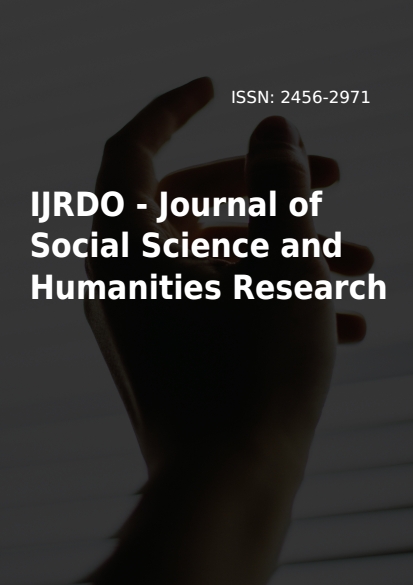lili royor, minahasa, tonsea Forms of Lingual Unit in Tonsean Lyrics of Lili Royor in North Minahasa
Forms of Lingual Unit in Tonsean Lyrics of Lili Royor in North Minahasa
Abstract
This research on Lili Royor dance focuses on its song lyrics, which highlight the language and culture used among Tonsea ethnicity, as reflected in their folksongs tradition. Lili Royor, one of Minahasan folksongs, has rich traditional wisdom and philosophy such as hard working, education, helping and loving each other, defending the country, respecting the elderly, and more importantly not forgetting brotherly relationship among them.
The aims of this research are to find out the language forms of the lyrics contained in the Lili Royor dance. This study is a descriptive and qualitative research (Denzin, 2009:265), using linguistics approach and is based on theories by Verhaar (2001:97) and Nida (1952:60).
The results show that the lyrics of Lili Royor utilize Tonsea dialect. The lingual forms in the lyrics are prefix, imperative, and particles; these repeated occurring forms are the smallest arbitrary and conventional meaningful language elements. The implied meanings of the lyrics show the highest feeling of brotherhood, which is niko manembo.
The research concludes that the lyrics of Tonsea folksongs in the Lili Royor dance consist of a series of lingual elements. This research has also described the types of words by classifying, categorizing and even by using towards the lyrics of Lili Royor. The lyrics contain the way of thinking of the people, which has been inherited for generations among Tonsea community. The linguistics analysis through morphological, syntactic and semantic analysis used in this research has revealed the cultural implications and the way of thinking of Tonsea ethnicity.
Downloads
References
Badudu, A.M. 2005. Morfosintaksis. Jakarta: P.T. Rineka Cipta
Christomy, T & Yuwono U, 2010. Semiotika Budaya. Depok: Pusat Penelitian
Kemasyarakatan dan Budaya Fakultas Ilmu Pengetahuan Budaya
Cummings, L. 2007. Pragmatik Sebuah Perspektif Multidisipliner.
Yogyakarta: Pustaka Pelajar
Danandjaja, J. 1984. Folklor Indonesia. Ilmu Gosip, Dongeng, dan lain lain.
Jakarta: Grafiti Pers.
Denzin, Norman K & Lincoln, Yvonna S. (eds.). 2009. Handbook of Qualitative
Research. Terjemahan dari bahasa Inggeris 1997 oleh Dariyatno cs. Yogyakarta: Pustaka Pelajar.
Djakaria, S. 2006. “Esagenang”. Jurnal Hasil Penelitian Jaranitra. Manado: Balai
Kajian Sejarah Dan Nilai Tradisional Manado
Djayasudarma, F.T. 1993. Metode Linguistik. Ancangan Metode Penelitian Dan
Kajian. Bandung: PT. Eresco.
Eco, U. 1992. Sebuah Pengantar Menuju Logika Kebudayaan dalam serba–serbi
Semiotika. Jakarta: PT Gramedia Pustaka Utama.
Endraswara, S. 2009. Metodologi Penelitian Folklor. Konsep, Teori, dan Aplikasi.
Jakarta: Buku Kita
Eriyanto. 2009. Analisis Wacana. Pengantar
Fairclough, N. 2003. Analysing Discourse. Textual analysis for Social Research.
New York: Routledge
Halliday & Hassan.R. 1992. Language, Context and Text. Victoria: Deakin
University Press.
Ibrahim.A.S.(Ed.). 2009. Metode Analisis Teks & Wacana. Terjemahan.
Yogyakarta: Pustaka Pelajar.
Kalangi, F.J. 2012. Kamus Tonsawang/Toundanow-Indonesia. Yayasan Institut
Seni Budaya Sulawesi Utara.
Kaunang, I et al. 2005. Sejarah Kabupaten Minahasa Utara. Manado: Pustaka
Gender BKOW Propinsi SULUT
Kepel, P.P. 2003. Perumpamaan Dalam Bahasa Tonsea. Manado: Percetakan
Wenang & Toko Lima
Leech, G. 1981. Semantics. The Study of Meaning. Suffolk, Great Britain: Richard
Clay Ltd.
Mangkey, S. 2015. Tou Dalam Bahasa Tolour. Suatu Kajian Etnolinguistik Di
Minahasa. Manado: Program PascaSarjana Universitas Sam Ratulangi.
Mantiri,E. 2018. Lirik ‘Marambak’ Cerminan Pola Pikir Membangun Rumah
Tinggal Orang Tombulu Di Minahasa. Manado: PascaSarjana Universitas
Sam Ratulangi .
Moningka, B. 1992. Tetambaken Wo Panginayoan Witu U Reraghesan Si
Empung. Bitung: Badan Pekerja Sinode GMIM
Nida, E.A. 1952. Morphology. The Descriptive Analysis of Words. Ann Arbor
USA: The University of Michigan Press.
Pinontoan, A. 1999. Reduplikasi Bahasa Tonsea. Manado: FPBS IKIP
Rahyono, F.X. 2009. Kearifan Budaya Dalam Kata. Jakarta: Penerbit Wedatama
Widya Sastra.
Ranuntu, Ch. 2012. Leksikografi Bahasa Tonsea. Manado: Program Pascasarjana
Unsrat.
Renwarin, P.R. 2012. Opo Empung – Wailan.Yang Ilahi Dalam Lirik Tembang
Minahasa. Yogyakarta: Penerbit Kanisius.
Renwarin, P.R. 2018. Matuari wo tona’as minaesa. Jilid II Mahkaria. Jakarta:
Cahaya Pineleng.
Rumengan, P. 2010. Maengket – Seni Tradisional Orang Minahasa.
Perkembangan Dan Permasalahan Vol.1. Yogyakarta: Program
Pascasarjana ISI
Samsuri, 1987. Analisis Bahasa. Memahami Bahasa secara Ilmiah. Jakarta:
Penerbit Erlangga
Sibarani, R. 2004. Antropolinguistik- Linguistik Antropologi. Medan: Penerbit Poda
Sudaryanto, 2015. Metode Dan Aneka Teknik Analisis Bahasa.Pengantar
Penelitian Wahana Kebudayaan secara Linguistis.Yogyakarta: Penerbit
Universitas Sanata Dharma Anggota APPTI
Sumarsono. 2009. Pengantar Semantik, Yogyakarta: Pustaka Pelajar.
Talangi, A.A.2017. Mahzani. Suatu Kajian Antropologi Budaya. Pineleng: Percikan Hati
Tambuwun, E.M. 2005. Tata Bahasa Tontemboan Jilid I & II. Amurang: Dinas
Pendidikan Minahasa Selatan.
Taulu, H.M. 1953. Lagu- Lagu Rakyat 10 Buah Minahasa dan 1 Buah Indonesia.
Jakarta: Departemen P & K .
Van Dijk, T.A. 1985. Handbook of Discourse Analysis Volume 1. Disciplines of
Discourse. London, Orlando, San Diego, New York, Toronto, Montreal,
Sydney, Tokyo: Academic Press.
Verhaar,J.W.M. 2001. Asas- Asas Linguistik Umum. Yogyakarta: Gadjah Mada
University Press.
-------- 1971. A Nuwu’ Ne Tombulu’ Rinewok Wo Ni Imek Pina’ Tuli-Tulian Ni
Pastor Ne Toumu’ung. Sinawang Ni Mester Tu’a. Tomohon: mimeograph.
-------- 1978. Struktur Bahasa Minahasa (Tombulu, Tonsea, Tondano). Manado:
Tim Peneliti Fakultas Sastra Universitas Samratulangi.
Copyright (c) 2020 IJRDO - Journal of Social Science and Humanities Research (ISSN: 2456-2971)

This work is licensed under a Creative Commons Attribution-NonCommercial-NoDerivatives 4.0 International License.
Author(s) and co-author(s) jointly and severally represent and warrant that the Article is original with the author(s) and does not infringe any copyright or violate any other right of any third parties, and that the Article has not been published elsewhere. Author(s) agree to the terms that the IJRDO Journal will have the full right to remove the published article on any misconduct found in the published article.


